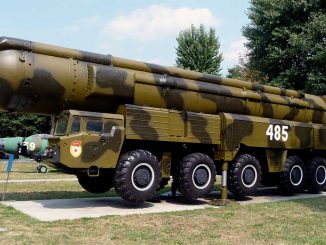“Elephants never lie,” as we all know… Impossible is definitely not Ukrainian! What on earth are these Ukrainians doing? We knew they were brave, tenacious and daring, but once again they have earned our admiration and respect. The story of the Antonov An-124-100, registered UR-82073, which was secretly refurbished before taking off under the Russians’ noses, is more than just the tale of a flight; it is a feat in more ways than one. The rebirth of UR-82073 represents a successful fusion of Ukraine’s national industrial policy, economic warfare, and military strategy.
Beyond the feat itself, it is the chronicle of an industrial and strategic resurrection, carried out in the heart of a country at war.
by Joêl-François Dumont — Paris, July 19, 2025 —
Table of Contents
Project Ruslan: Anatomy of an Aeronautical Feat in Wartime
To understand the magnitude of the feat that took place on 11 July 2025, we must look back at the state of the aircraft at the start of the conflict and the monumental project undertaken by Antonov’s engineers, who turned a technical challenge into an act of national defiance. This was not a simple repair, but a strategic reorientation carried out under enemy fire.
I. The Phoenix of Sviatoshyn: The Rebirth of a Stranded Giant
The story of the Antonov An-124-100, registered as UR-82073, is much more than a simple flight record.
It is the chronicle of an industrial and strategic resurrection, conducted in the heart of a country at war. To understand the magnitude of the feat of July 11, 2025, it is imperative to look back at the aircraft’s condition at the beginning of the conflict and the monumental project undertaken by Antonov’s engineers, who turned a technical challenge into an act of national defiance. This was not a simple repair, but a strategic reorientation executed under enemy fire.
A Giant in Hibernation: The Status of UR-82073
The aircraft at the center of this event is an Antonov An-124-100, bearing the serial number 0706 and registration UR-82073.[01][02] Manufactured in 1994, this heavy transport aircraft already had a full career, with over 21,000 flight hours and 5,500 missions to its credit before being grounded.[01][03][04] Its last recorded flight before its long immobilization was on March 13, 2021, when it landed in Kyiv.[05]

A crucial geographical detail sealed its fate and ensured its survival. At the time of the full-scale Russian invasion in February 2022, UR-82073 was not at Hostomel Airport, which would become the scene of fierce fighting and the site of the destruction of the iconic An-225 Mriya and another An-124 (UR-82009).[06][07][08]

Instead, it was parked at the Sviatoshyn airfield in Kyiv, the site of Antonov’s serial production plant.[09][10][11][12] This location, combined with its condition, proved to be its salvation. The aircraft was then undergoing a deep modernization and was in a « dismantled state, » which made it unable to fly but also protected it from the first waves of attacks targeting operational airport infrastructures.[01][02][03][10][11]
De-Russification Under Fire: The Modernization Mandate
The modernization project for UR-82073 was not born out of the war; it preceded it. Launched in 2021, its strategic objective was clear: « to replace the main Russian-made components with modern Western and Ukrainian-made components. »[01][02][11][13] This initiative, prior to the 2022 invasion, reflects a long-term strategy by Ukraine to decouple from Russian supply chains, a trend observed since the annexation of Crimea in 2014.
The full-scale invasion transformed this strategic objective into an imperative necessity. The work was initially suspended due to the direct threat to Kyiv during the battle for the capital.[01][02][03] However, the decision by the Antonov team to resume and complete the project, which was finished in June 2025, « under the most difficult conditions of war, » is at the heart of the narrative of Ukrainian resilience.[01][02][03] The logistical and security challenges were immense: sourcing complex Western parts in the midst of conflict, protecting facilities from near-daily air raids, and maintaining a highly skilled workforce in a besieged city. The completion of this project in such a context demonstrates that it was an absolute national priority, far exceeding a simple corporate project. This success sets a crucial precedent and a model for the entire Ukrainian defense industry, proving its ability to integrate Western technologies into complex Soviet-era platforms, a vital skill for its long-term sustainability and deeper interoperability with NATO.
The Digital Heart: A Western Avionics Overhaul
The most detailed and significant aspect of this modernization concerns the avionics. Press releases from the Canadian firm CMC Electronics, dated June 16, 2025, confirm the signing of a major contract with Antonov, finalized on April 9, 2025.[14][15] This agreement covered a complete upgrade of the An-124’s avionics, equipping it with a glass cockpit and state-of-the-art navigation systems. This modernization is not just an improvement; it is a fundamental transformation that increases safety, reduces the crew workload from six to four, and, most importantly, ensures the aircraft’s compliance with modern international airspace requirements, such as Precision Area Navigation (P-RNAV).[16] This compliance is absolutely essential for its future commercial viability on global routes.
Table 1: CMC Electronics Avionics Modernization Suite for An-124 UR-82073
| Component | Function / Capability | Strategic Advantage |
|---|---|---|
| CMA-9000 Flight Management System (FMS) | Central navigation and flight planning computer, integrating performance data and flight plans. | Enables P-RNAV compliance for access to modern airspace; reduces crew workload; optimizes flight routes for better fuel efficiency. |
| CMA-5024 GPS Receiver | Provides high-precision satellite positioning, essential for modern navigation. | Significantly improves navigation accuracy and reliability, reducing dependence on ground-based navigation systems. |
| MFD-3068 Multi-Function Display (MFD) | Main glass cockpit display showing flight, navigation, and aircraft systems data. | Enhances pilot situational awareness; replaces aging analog instruments with a clear, integrated digital interface. |
| ECP-083 EFIS Control Panel | Interface allowing pilots to control and configure the Electronic Flight Instrument System (EFIS) displays. | Facilitates human-machine interaction, making flight information management more intuitive and efficient. |
| CMA-1612 Electronic Display Unit | Compact display unit for critical flight information. | Provides redundancy and quick access to essential data, increasing overall safety. |
| Autopilot Control Panel | Control interface for the modernized autopilot system. | Allows for more precise control and more sophisticated automated flight modes, reducing crew fatigue on long journeys. |
Power and Performance: New Engineering for a New Era
Beyond avionics, the modernization was comprehensive. Some sources claim the upgrade included « new engines, new avionics, and expanded performance envelopes. »[12] Although the specific model of the replacement Western engine is not explicitly identified in the available information, this claim is in itself of paramount importance. The original Lotarev D-18T engines were known for their reliability issues and poor fuel efficiency. A replacement with a Western equivalent would represent a major qualitative leap in terms of performance, reliability, and maintainability. The technical challenge of such a re-engining is immense, often requiring significant airframe modifications. The modernization also addressed other critical systems, such as brakes and tires, which were reinforced to support the increased performance of a modernized variant, potentially similar to the An-124-100M-150, which can carry a payload of 150 tons.[16]
To crown this technical renaissance, the aircraft now bears the slogan « BE BRAVE LIKE IRPIN » on its fuselage.[03][12] This message is not trivial; it establishes a powerful and direct symbolic link to one of the most brutal and decisive battles of the early war, where Ukrainian resistance halted the Russian advance on Kyiv. The aircraft thus becomes a flying memorial.
II. The Kyiv Gambit: A Secret Flight in a Contested Sky
The flight of UR-82073 was not a simple evacuation, but a meticulously planned military-style operation. By combining open-source intelligence (OSINT) analysis and an understanding of modern air warfare doctrine, it is possible to reconstruct the event and expose the glaring Russian intelligence failures that made it possible.
The Takeoff from Sviatoshyn: Demystifying the Dnipro Diversion
The aircraft’s takeoff location has been the subject of speculation, but converging evidence conclusively establishes that the flight departed from the Sviatoshyn airfield in Kyiv. Several elements support this conclusion:
- Official statements from Antonov confirm that the aircraft was at their Kyiv facilities for modernization.[01][03][10]
- Satellite images from Planet Labs, analyzed by defense experts, showed two An-124s at Sviatoshyn on July 2, with one of them moving towards the runway on July 5, indicating active preparations for a flight.[05][09][17]
- Visual sightings over Kyiv showed the aircraft at low altitude, with its landing gear still extended or being retracted, a typical configuration for an aircraft that has just taken off from a nearby airport.[05][08]
The alternative theory, that the flight departed from Dnipro, is most likely the result of Russian disinformation or confused speculation.[05][09][17][18] The idea that the aircraft used a fake drone transponder code, « PTNPNH2″—a nod to a well-known anti-Putin slogan in Ukraine—has been deemed « highly questionable » by analysts.[05][09][17][18] This theory does not explain why an aircraft that departed from Dnipro, hundreds of kilometers to the east, would overfly Kyiv at low altitude.
Slipping Through the Cracks: Evasion Tactics and Airspace Control
The flight of July 11, 2025, was a masterful demonstration of operational security (OPSEC) in a high-risk environment. To succeed, several tactics and flawless coordination were necessary.
- Electronic Silence: The most obvious tactic was to turn off the aircraft’s transponder for most of its journey over Ukraine to avoid electronic detection by Russian surveillance systems. The aircraft only activated its transponder as it approached the Polish border, around 2:17 PM local time, making its track visible on flight tracking sites like Flightradar24 only at the end of its Ukrainian journey.[06][18][19]
- Military Coordination: This was by no means a standard civilian flight. Such an operation required extensive military coordination at multiple levels. First, airspace deconfliction had to be organized to create a safe corridor through Ukraine’s own dense air defense network, to avoid a catastrophic friendly fire incident. This implies a high-level order within the Ukrainian Air Force command. Second, ground security was essential to secure the Sviatoshyn airfield and clear the runway, which, like others in Ukraine, is typically obstructed to prevent any Russian airborne landing attempts.[9] Finally, intelligence support was fundamental. The choice of flight path and time was most likely dictated by precise intelligence on gaps in Russian radar coverage and the position of their long-range air defense assets and fighters.
An Intelligence Failure in Moscow
The success of this flight caused fury and embarrassment within Russian military blogger circles, offering a transparent window into their perceived failures. The « Fighterbomber » Telegram channel, known for its close ties to the Russian Aerospace Forces, was widely quoted, calling the event « sad, of course. For our intelligence above all. »[05][08][09][20]
Its analysis is scathing and reveals a cascade of failures. Russia failed to conduct basic surveillance of one of the few airfields in Ukraine capable of hosting an An-124.[05][08] It failed to detect preparations that were visible on commercial satellite images. More damningly, it failed to destroy a high-value, static target whose position had been known for over three years.
This highlights a systemic breakdown in the Russian « kill chain »: from intelligence gathering (ISR) to execution, through decision-making. The Russian military’s « ossified kill chain » proved too slow and ineffective to react to a dynamic target, even one as large and slow as an An-124.[05] The flight was therefore not just an « escape »; it was a special operation deliberately executed to achieve a strategic objective while demonstrating the impotence of Russian anti-access/area denial (A2/AD) capabilities over the Ukrainian capital. The fact that it took place in broad daylight over Kyiv was not recklessness, but a public and deliberate act of defiance. This operation served as a powerful psychological warfare tool, undermining the confidence of the Russian military and public in their own capabilities while providing a huge morale boost to Ukraine.
III. A Resurrected Strategic Asset: The Economic and Military Impact
The recovery of UR-82073 is not just symbolic; it has tangible and significant economic and military repercussions. By rejoining the operational fleet, this aircraft strengthens the logistical capacity of Ukraine and its NATO allies, while inflicting an economic setback on Russia.

Strengthening the Leipzig Hub: Antonov Airlines’ Lifeline
With the arrival of UR-82073, the operational fleet of Antonov Airlines based at Leipzig/Halle Airport (LEJ) in Germany now numbers six An-124s.[06][21] This represents a 20% increase in the airline’s heavy-lift capacity, a significant jump for such a specialized and small fleet.
The An-124 is a crucial economic asset for Ukraine.[09] In the highly specialized and restricted market for outsize and super-heavy cargo, Antonov Airlines now holds an even more dominant position, especially as its main competitor, the Russian company Volga-Dnepr, is marginalized by international sanctions.[21] The market dynamics analysis is telling: leasing an An-124 costs between $70,000 and $100,000 per flight hour.[22] The addition of a sixth aircraft allows Antonov to generate millions of additional dollars in hard currency, revenue that can be reinvested in the national defense effort.
Table 2: Status of the Antonov Airlines An-124 Fleet (July 2025)
| Registration | Status | Key Notes |
|---|---|---|
| UR-82073 | Operational (Leipzig) | Returned to service in July 2025 after complete modernization in Kyiv. |
| UR-82027 | Operational (Leipzig) | Active in the fleet, participating in commercial and SALIS operations. |
| UR-82007 | Operational (Leipzig) | Active in the fleet, participating in commercial and SALIS operations. |
| UR-82008 | Operational (Leipzig) | Active in the fleet, participating in commercial and SALIS operations. |
| UR-82060 | Operational (Leipzig) | Active in the fleet, participating in commercial and SALIS operations. |
| UR-82072 | Operational (Leipzig) | Active in the fleet, participating in commercial and SALIS operations. |
| UR-82009 | Damaged (Hostomel) | Suffered significant damage during the battle for Hostomel Airport in February 2022. Status under evaluation. |
The NATO Connection: Strengthening the SALIS Bridge
The strategic importance of this aircraft extends directly to NATO. Antonov Airlines is the main contractor for the Strategic Airlift International Solution (SALIS) program, which provides nine NATO member countries with assured access to An-124s for strategic transport.[24][25][26] These aircraft are indispensable for transporting equipment that is too large or too heavy for most Western military transport aircraft like the C-17 or A400M.22][27] They are used to transport a wide range of materials, from helicopters and combat vehicles to humanitarian aid and disaster relief supplies.[[24][25]

The SALIS contract is essential for strengthening NATO’s eastern flank and for delivering military aid to logistics hubs in Eastern Europe, from where it is then shipped to Ukraine. The increased availability of the Antonov fleet directly enhances NATO’s logistical capacity and operational responsiveness.
Table 3: Comparative Analysis: An-124-100M vs. Lockheed C-5M Super Galaxy
| Metric | Antonov An-124-100M | Lockheed C-5M Super Galaxy |
|---|---|---|
| Maximum Payload | 150,000 kg | 129,274 kg |
| Cargo Hold Volume | 1,050 m³ | 880 m³ |
| Cargo Hold Dimensions (L x W x H) | 36.5 m x 6.4 m x 4.4 m | 37 m x 5.8 m x 4.1 m |
| Range (with 120t payload) | 5,200 km | ~4,445 km (with max payload) |
| Takeoff Distance (MTOW) | ~3,000 m | ~2,530 m |
This table highlights the superiority of the An-124 in terms of payload and cargo hold dimensions, explaining why it occupies an irreplaceable niche for transporting certain types of « outsize » cargo.
A Symbol Forged in War: « Be Brave Like Irpin »
Antonov’s official statement perfectly summarizes the scope of the event: « The relocation of the Ruslan is not just a technical achievement—it symbolizes the resilience, professionalism, and unity of Ukrainian aeronautical engineers. »[01][02][03][10][13] The flight was celebrated by Ukrainians as a moment of immense pride and defiance.[17][18] Seeing a Ukrainian-made giant fly freely over the capital after years of missile and drone attacks was a powerful boost to national morale.
The slogan « BE BRAVE LIKE IRPIN » painted on the fuselage transforms the aircraft from a simple commercial asset into a flying monument to Ukrainian courage and a powerful instrument of public diplomacy.[03][12] The rebirth of UR-82073 thus represents a successful fusion of national industrial policy, economic warfare, and military strategy. Ukraine is using a commercial enterprise as a strategic weapon: it generates revenue for the state, provides a critical capability to its key military partner, NATO, and inflicts direct economic damage on the enemy by capturing market share from its sanctioned Russian rival.
It is a case study of how a state can mobilize its unique industrial capabilities in a total war scenario.
IV. The Global Ruslan Fleet: A Geopolitical Chessboard
The story of UR-82073 is part of a larger context: the struggle for control of the global An-124 fleet, a unique and finite logistical asset. This fleet has become a veritable chessboard on which a major geopolitical game is being played between Ukraine and Russia, with the West as the arbiter.
A Tale of Two Fleets: Antonov vs. Volga-Dnepr
The current situation highlights a striking contrast between the two main operators of the An-124. On one side, Antonov Airlines is in the midst of a renaissance. Its fleet, modernized, aligned with Western standards, and in high demand, operates from a secure base in Germany.[[06][10] The company is not only viable but is also a strategic partner of NATO.

On the other side, the fleet of the Russian company Volga-Dnepr is fractured and paralyzed. Several of its An-124s are grounded abroad due to international sanctions. One aircraft, RA-82078, has been stuck in Toronto, Canada, since February 2022.[06][07][28] Three others are grounded at Leipzig Airport, ironically the same airport that serves as Antonov’s new base.[07][21][29] This situation is a direct result of Russia’s strategic isolation and economic impotence on the world stage. Ukraine is leading a legal and political offensive to have these seized Russian assets transferred to it as war reparations.[06][07][29] This « hunt for the Ruslans »[29] is a key front in the economic war being waged against Russia.
The Future of the Condor: Maintaining a Strategic Advantage
The focus now turns to the future. The successful modernization of UR-82073 with Western avionics [14][15] and potentially new engines sets the standard for the rest of the Antonov fleet. Continued investment in these upgrades is essential to extend the life of these valuable aircraft—Antonov estimates it can be extended by more than 15 years [26]—and to ensure their continued compliance with international aviation regulations.

The strategic partnership with NATO through the SALIS program should be deepened, positioning Antonov Airlines as the Alliance’s indispensable heavy-lift provider for the future, especially since no direct Western equivalent is in production. The ultimate outcome of this strategy would be the legal transfer of the seized Russian An-124s. Such a measure would not only compensate Ukraine; it would decisively cripple Russia’s heavy-lift capability globally for a generation.
In conclusion, the An-124 fleet has become a major geopolitical lever. For Ukraine, it is a source of revenue, a tool of alliance policy with NATO, and a potential source of reparations. For Russia, its grounded fleet is a symbol of its strategic isolation. Control of the limited global fleet of operational An-124s is equivalent to control of a unique logistical capability.

Ukraine, through its actions and diplomacy, is consolidating this control. The future of the An-124 is now inextricably linked to the outcome of the war and the post-war settlement. The decision made regarding the seized Russian aircraft will be a major indicator of the West’s willingness to make Russia pay the price for the conflict, and it will determine the balance of power in the strategic airlift market for decades to come. The feat of July 11, 2025, was not the end of the story, but the beginning of a new, decisive chapter.
Joël-François Dumont
See Also:
- « The Rebirth of a Stranded Giant » — (2025-0719) —
- « Eine fliegerische Meisterleistung in Kriegszeiten » — (2025-0719) —
- « Le Phénix de Sviatoshyn » — (2025-0719) —
- « Святошинський Фенікс » — (2025-0719) —
Footnotes
- [01] Antonov Company, Communiqué officiel (12 juillet 2025).
- [02] The Drive, « Details Emerge About An-124 Condor’s Mystery Flight Through Kyiv’s Restricted Airspace » (12 juillet 2025).
- [03] The Warzone, « Antonov An-124 flies over Kyiv and lands in Leipzig » (11 juillet 2025).
- [04] Forbes, « An-124 Ruslan escapes Ukraine war zone » (12 juillet 2025).
- [05] The Drive, « Lumbering An-124 Condor Cargo Jet Appears In Kyiv’s Highly-Restricted Airspace » (11 juillet 2025).
- [06] The Warzone, « An-124-100 Ruslan transport aircraft of Antonov Airlines flew from Kyiv » (11 juillet 2025).
- [07] Forbes, « How Ukraine Snatched A Giant Cargo Plane From Under The Russians’ Noses » (12 juillet 2025).
- [08] The Drive, « Ukraine’s Giant An-124 Cargo Jet Just Flew Out Of Kyiv » (11 juillet 2025).
- [09] Kyiv Post, « Ukraine’s ‘Condor’ An-124 Transport Aircraft Appears in Kyiv’s Airspace » (11 juillet 2025).
- [10] Aerotime Hub, « Antonov An-124 seen flying over Kyiv, lands in Leipzig » (11 juillet 2025).
- [11] Simple Flying, « Giant Antonov An-124 Transport Aircraft Appears In Kyiv’s Skies » (11 juillet 2025).
- [12] Militarnyi, « The An-124 Ruslan, which was in Kyiv, flew to a European airport » (11 juillet 2025).
- [13] Avianews, « Antonov Airlines’ An-124 flew out of Ukraine for the first time since the beginning of the war » (12 juillet 2025).
- [14] CMC Electronics, Communiqué de presse, « CMC Electronics to Supply a New Generation Avionics Suite for the Antonov AN-124 Aircraft » (16 juin 2025).
- [15] FlightGlobal, « CMC to provide new avionics for Antonov An-124s » (17 juin 2025).
- [16] Antonov, Spécifications techniques de l’An-124-100M-150.
- [17] Planet Labs, Imagerie satellite analysée par des experts en défense (e.g., @MT_Anderson sur X), (2-5 juillet 2025).
- [18] Euromaidan Press, « Ukrainian An-124 cargo plane reportedly escapes from Kyiv to Leipzig » (11 juillet 2025).
- [19] Flightradar24, Données de suivi de vol pour UR-82073 (11 juillet 2025).
- [20] Chaîne Telegram « Fighterbomber » (11 juillet 2025).
- [21] Aéroport de Leipzig/Halle (LEJ), Communiqué de presse sur l’accueil de la flotte Antonov (12 juillet 2025).
- [22] Air Charter Service : Analyse des coûts de location d’un An-124.
- [23] Planespotters.net : Base de données de la flotte d’Antonov Airlines.
- [24] OTAN, Fiche d’information sur le programme Strategic Airlift International Solution (SALIS).
- [25] Bundeswehr, « SALIS: Strategic Airlift Capability for NATO« .
- [26] Antonov Company, Informations sur la participation au programme SALIS et l’extension de la durée de vie des appareils.
- [27] Aerospace-technology.com : Analyse comparative des avions de transport stratégique.
- [28] CBC News, « Russian cargo plane stuck at Toronto’s Pearson airport for months » (15 juin 2022).
- [29] Air Cargo News, « Ukraine seeks seizure of Russian An-124s » (10 mai 2022).











